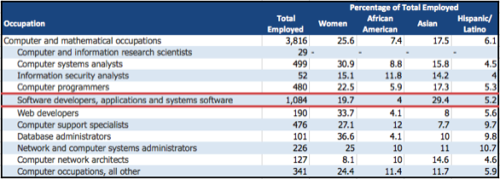If tech’s “dirty little secret” is that it’s still mostly male and mostly white, open source has an even dirtier secret: its practitioners are even less diverse than those in proprietary software. For an empowering phenomenon that encourages developers to “scratch their own itches,” open-source projects thus run the risk of tackling a very narrow universe of technical problems.
Diversity: Anywhere But Here
According to Evans Data, the global developer population tops 18.2 million today and should boom to 26.4 million by 2019. Even by the U.S. Department of Labor’s somewhat narrow definition of a software developer, the U.S. population of developers should grow 30% between 2010 and 2020 to over 1 million jobs. As impressive as this growth is, India and China will significantly outpace the U.S. or Europe in developer population growth.
Given the importance of developers—Stephen O’Grady, an analyst with Redmonk, declares that “developers are the new kingmakers”—as well as the importance of technology, it’s critical that the developer population represent the widening array of the world’s application requirements.
Today, it doesn’t.
By some estimates, men dominate 94% of application development jobs. But things have been getting better. Though systemic cultural, educational and workplace barriers persist, women and ethnic minorities are today far more represented in software programming than they were 10 years ago, as U.S. Department of Labor data shows:

But not in open source.
Open Source: Strangely Homogeneous
Turns out that women in open source are scarce indeed. This 2006 report suggested that a mere 1.5% of open-source developers are women, although it’s not totally clear where that number comes from. (Thanks to writer Bruce Byfield for the link; he cited the report here.) Back in 2002, only 1.1% of respondents to an open-source survey were women. A 2013 open-source survey recently finished collecting data; while it hasn’t completed its analysis, the unfiltered raw data on its site shows that women made up just over 10% of respondents.
As I’ve written, most open-source developers are white, middle-class males with a few kids. They’re not women, and they’re generally white. This may change as India and China expand their developer pools: a significant percentage of these developers will find their way to open source. Indeed, they already are.
But this still doesn’t explain why open source, so innovative in both technology and methodology, is such a laggard when it comes to developer diversity. There is no easy answer.
Proprietary software companies, as Accenture managing director Rodrigo Flores points out, actively promote diversity. Open-source projects, by contrast, don’t have HR directors and generally don’t actively recruit, either. In open source, you show up and earn leadership through code contributions. This approach doesn’t seem to translate into active women or minority participation, though some projects like Eucalyptus have much higher levels of female participation.
Maybe, as Ashe Dryden posits, the problem is time:
OSS contribution takes time; I don’t think anyone would contest that. Getting familiar with a project, finding out where you can fit into it, reading and responding to issues, testing and submitting patches, writing documentation. All of that requires a good deal of time.
Marginalized people in tech—women, people of color, people with disabilities, LGBTQ people, and others—have less free time for a few major reasons: dependent care, domestic work and errands, and pay inequity.
This would be more persuasive, however, if, as Justin James has highlighted, so many open-source developers weren’t paid to write open-source code. It’s a fair point that a system designed to operate on the free time of its participants would punish those without free time. But open source doesn’t really work that way.
A Problem Of Culture?
Or maybe open source is culturally toxic to would-be minority contributors. We’ve certainly shown a propensity to crassness toward women, as the Pycon “Donglegate” demonstrated. In the open source world, there is no safety net and no real on-ramp to participation. Communities self-police, and not always very well. Stepping into a overwhelmingly white, male community could be difficult, even if the community itself isn’t overtly exclusionary.
James offers an alternative spin on culture. He argues that in developing economies getting a quality job is the first priority, and coding for fun/personal fulfillment is secondary. The same could also be true of women developers no matter the loation.
I’m somewhat persuaded by these cultural explanations. As a married father of three strong daughters, I’m constantly surprised by perceived and actual barriers that impede them. Often the barriers aren’t purposefully imposed. They’re just there, including simple things like the inability to walk alone at night without being worried for their personal safety. These are things that men, and particularly white men, never really have to think about.
So perhaps that also points to the solution: open-source communities that want to attract the best and brightest, whatever their gender or ethnicity, should actively welcome developers that don’t fit the “white”, “male” mold. They should make it easy for others to fit in, not only based on the quality of their code, but also the quality of the different perspective they may bring to that code.





















